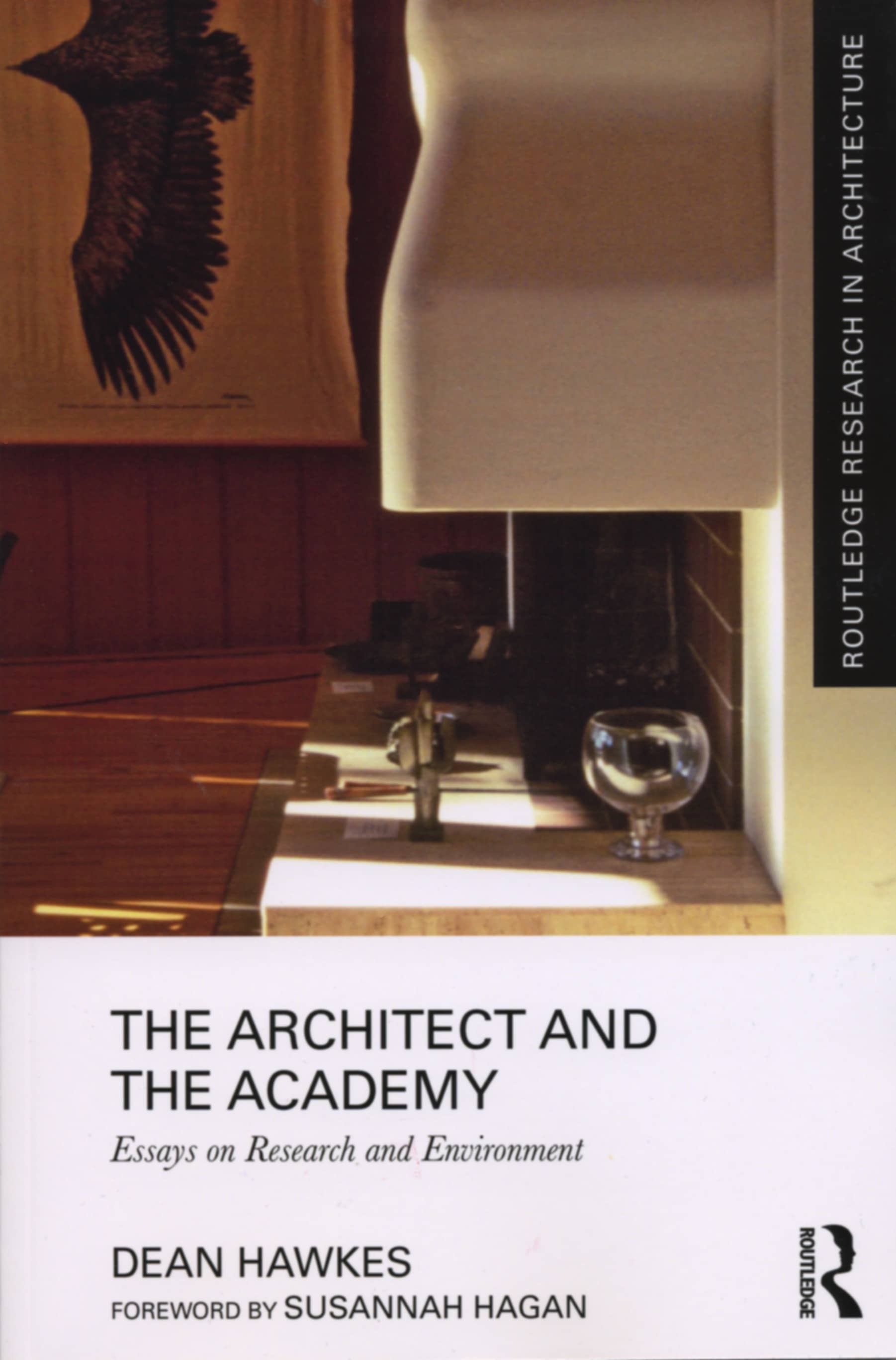
www.buildingsandcities.org/insights/reviews/architect-and-the-academy.html
The Architect and the Academy: Essays on Research and the Environment
By Dean Hawkes. Routledge, 2022, ISBN: 9780367537166
Sherry McKay (emeritus professor, University of British Columbia) reviews this book on design research and the role of the profession in the advancement of architecture and environmental design. It clearly demonstrates the contribution of design practice to advancing the discipline of architecture, especially in its synthesis of science, precedent and imagination.

This book is a collection of eleven short essays organised into two parts, one plotting the recent history of architectural education and research within academic settings and the other a particular strain of research related to environments. The essays, previously published between 1995 and 2017, are arranged thematically and bound together by an autobiographical thread.
The first four essays form a coherent group that focus on the relationship between the academy and practice as it developed primarily at Cambridge in postwar WWII Britain. These capture the author's engagement with the academicisation of architecture as student and subsequently as practitioner and educator at the University of Cambridge. Together the essays elaborate on the contribution of architects within academic settings to research through both practice and design studio instruction, and to the discipline via critical practice and critical commentary. Although the book is focused on developments in Britain and the environment of sense perception, many of the issues and debates recounted here will be familiar to those beyond Britain. It is Hawkes' personal account and assessment of shifts in the relationship of practitioners to pedagogy during this period and the accompanying historical evidence of the value of design-based research that makes this history both engaging and insightful.
The initial essays highlight some of the major questions that have vexed architectural education as it became primarily a university discipline in the mid-20th century: in what way is architecture a discipline, how might the value of the design studio be demonstrated in the context of established methodologies of the humanities and sciences, what constitutes architectural research and, most importantly for Hawkes, what is the role of practice in establishing research objectives and methodologies? Most who teach within university architecture programs will recognise the issues embedded in these questions and will have experienced at some point the friction between practice and the academy, their often-differing objectives, evaluation regimes, and aspirations. Some of the concerns raised by Hawkes' reflective account of architectural education can be discerned in architectural thought at least since the Renaissance when design was elevated above construction and the distinction between design as representation and as material object facilitated an undermining of the medieval guild system (practice) in favour of a liberal arts basis (theory). A renegotiation of this division between craft and liberal art can be seen in the Bauhaus pedagogical proposal synthesising Werklehre (workshop/making) with Formlehre (form/ art theory) in the 1920s. These precedents, in differing degrees, recognised architecture as a work of materiality and object of experience and as a representation of an underlying idea or speculation. It is the negotiation of these two possible meanings of design as a representation of an idea and as the material object that allows architecture to be taught within the academy and contributes to the tensions between practice and pedagogy within an academic environment. The mid-20th century zeal to replace apprenticeship with university instruction as the route to professional practice refocused the debates about design, the validation of its concepts, and its relationship to practice. In Britain the 1958 Oxford Conference on architectural education was influential in transforming architecture into a more academic study with research in the profession given greater emphasis. This was a turning point for British schools of architecture - and met with great resistance.Hawkes' contribution is to highlight the potential of built form as well as studio design work to be considered a form of research and a means of advancing the discipline.
A reference point for Hawkes' (p. 8) writing about architecture and its place within an academic structure is Leslie Martin's 1958 proposition (made in Martin's report on the Oxford Conference) that:
"[t]heory is the body of principles that explains and interrelates all the facts of the subject. Research is the tool by which theory is advanced. Without it, teaching can have no direction and thought no cutting edge."
It is reiterated in some form in each of the first four essays (p.16, 22, 28 & 37). Hawkes tellingly amends this statement to refer to architecture as a discipline rather than a subject and to add critical practice to research as a tool for the advancement of theory (p.2).
The work of critical practice, an "activity in which projects were subject to agendas that extended beyond the circumstances of each individual project" (p.12), as opposed to ordinary practice (which does not) is central to the subsequent seven essays. These essays are arranged thematically and dedicated to the work of historical and 20th century practitioners that serve as evidence of the symbiosis of research and critical practice within and beyond the university. One of the stated aims of the book is to counter the diminished role and status of the academic practitioner who, Hawkes argues, has a role to play in offering critical commentary on design in addition to practice as a means of furthering innovation. These seven essays are themselves examples of such critical commentary on architectural projects that synthesise research on environmental aspects of building design with experience and precedent in innovative ways. Here, the environment is explored through an experiential consideration of climate, temperature, light, and sound. The examples, which range in date from the English Renaissance to the canonical figures of the 20th century, function as a form of evidence for the persistent role of design as a form of research integral rather than preliminary to architectural innovation.
The collection of essays, which provide the history and evidence of design as a form of research, are enjoyable to read and offer purposeful insights into the exploration of environmental aspects of buildings and the masterful execution of a set of environmental responses at an intimate scale: the environments of ambient temperature, expressive illumination, and acoustic surround rather than the larger environment of sustainability or climate change response. The attentive analysis of form, materiality, and detail offers a discriminating revelation of the working of design informed by precedent and experiment in addition to building science. It is clearly this larger argument that matters here and perhaps explains certain editorial lapses: numbers embedded in plans bereft of a key or reference in the text, lack of orientation indicated on plans, illustrations that often appear as icons rather than additional visual information. The abrupt ending with no conclusion or summary comments lends the book a retrospective quality that is no doubt intentional, but one wishes that the intelligent, cogent and engaging elucidation of architectural research as it is evidenced in practice and projects of the distant and recent past had been extended to more current work and the altered environments in which it is produced. These are perhaps small quibbles.
The assembly of these essays into one coherent collection serves to demonstrate a consistent contribution of design practice to advancing the discipline, especially in its synthesis of science, precedent and imagination in responding to environmental demands placed on buildings. While each essay presents an interesting description of specific projects and their individual engagement with science and received disciplinary knowledge, the collection as a whole creates a cumulative effect of a pattern of thought, defining a discipline.
The footnotes reveal an impressive array of publication venues in which the essays were originally vetted and published. These include Architectural Research Quarterly, Interdisciplinary Science Reviews, Further Studies in the History of Construction, Daylight and Architecture, The Journal of Architecture. The research, examples and arguments presented in the essays have also been elaborated in his books. Collectively they are a testament to both Hawkes' commitment to, and consideration of, design research and the role of the profession in the advancement of the discipline, especially in its addressing of the environmental aspects of design. Here, Hawkes himself can be situated as an exemplar of research and critical commentary.
Latest Peer-Reviewed Journal Content
A framework for 1.5°C-aligned GHG budgets in architecture
G Betti, I Spaar, D Bachmann, A Jerosch-Herold, E Kühner, R Yang, K Avhad & S Sinning
Net zero retrofit of the building stock [editorial]
D Godoy-Shimizu & P Steadman
Co-learning in living labs: nurturing civic agency and resilience
A Belfield
The importance of multi-roles and code-switching in living labs
H Noller & A Tarik
Researchers’ shifting roles in living labs for knowledge co-production
C-C Dobre & G Faldi
Increasing civic resilience in urban living labs: city authorities’ roles
E Alatalo, M Laine & M Kyrönviita
Co-curation as civic practice in community engagement
Z Li, M Sunikka-Blank, R Purohit & F Samuel
Preserving buildings: emission reductions from circular economy strategies in Austria
N Alaux, V Kulmer, J Vogel & A Passer
Urban living labs: relationality between institutions and local circularity
P Palo, M Adelfio, J Lundin & E Brandão
Living labs: epistemic modelling, temporariness and land value
J Clossick, T Khonsari & U Steven
Co-creating interventions to prevent mosquito-borne disease transmission in hospitals
O Sloan Wood, E Lupenza, D M Agnello, J B Knudsen, M Msellem, K L Schiøler & F Saleh
Circularity at the neighbourhood scale: co-creative living lab lessons
J Honsa, A Versele, T Van de Kerckhove & C Piccardo
Positive energy districts and energy communities: how living labs create value
E Malakhatka, O Shafqat, A Sandoff & L Thuvander
Built environment governance and professionalism: the end of laissez-faire (again)
S Foxell
Co-creating justice in housing energy transitions through energy living labs
D Ricci, C Leiwakabessy, S van Wieringen, P de Koning & T Konstantinou
HVAC characterisation of existing Canadian buildings for decarbonisation retrofit identification
J Adebisi & J J McArthur
Simulation and the building performance gap [editorial]
M Donn
Developing criteria for effective building-sector commitments in nationally determined contributions
P Graham, K McFarlane & M Taheri
Reimagining circularity: actions for optimising the use of existing buildings
R Lundgren, R Kyrö, S Toivonen & L Tähtinen
Effective interdisciplinary stakeholder engagement in net zero building design
S Vakeva-Baird, F Tahmasebi, JJ Williams & D Mumovic
Metrics for building component disassembly potential: a practical framework
H Järvelä, A Lehto, T Pirilä & M Kuittinen
The unfitness of dwellings: why spatial and conceptual boundaries matter
E Nisonen, D Milián Bernal & S Pelsmakers
Environmental variables and air quality: implications for planning and public health
H Itzhak-Ben-Shalom, T Saroglou, V Multanen, A Vanunu, A Karnieli, D Katoshevski, N Davidovitch & I A Meir
Exploring diverse drivers behind hybrid heating solutions
S Kilpeläinen, S Pelsmakers, R Castaño-Rosa & M-S Miettinen
Urban rooms and the expanded ecology of urban living labs
E Akbil & C Butterworth
Living with extreme heat: perceptions and experiences
L King & C Demski
A systemic decision-making model for energy retrofits
C Schünemann, M Dshemuchadse & S Scherbaum
Modelling site-specific outdoor temperature for buildings in urban environments
K Cebrat, J Narożny, M Baborska-Narożny & M Smektała
Understanding shading through home-use experience, measurement and modelling
M Baborska-Narożny, K Bandurski, & M Grudzińska
Building performance simulation for sensemaking in architectural pedagogy
M Bohm
Beyond the building: governance challenges in social housing retrofit
H Charles
Heat stress in social housing districts: tree cover–built form interaction
C Lopez-Ordoñez, E Garcia-Nevado, H Coch & M Morganti
An observational analysis of shade-related pedestrian activity
M Levenson, D Pearlmutter & O Aleksandrowicz
Learning to sail a building: a people-first approach to retrofit
B Bordass, R Pender, K Steele & A Graham
Market transformations: gas conversion as a blueprint for net zero retrofit
A Gillich
Resistance against zero-emission neighbourhood infrastructuring: key lessons from Norway
T Berker & R Woods
Megatrends and weak signals shaping future real estate
S Toivonen
A strategic niche management framework to scale deep energy retrofits
T H King & M Jemtrud
Generative AI: reconfiguring supervision and doctoral research
P Boyd & D Harding
Exploring interactions between shading and view using visual difference prediction
S Wasilewski & M Andersen
How urban green infrastructure contributes to carbon neutrality [briefing note]
R Hautamäki, L Kulmala, M Ariluoma & L Järvi
Implementing and operating net zero buildings in South Africa
R Terblanche, C May & J Steward
Quantifying inter-dwelling air exchanges during fan pressurisation tests
D Glew, F Thomas, D Miles-Shenton & J Parker
Western Asian and Northern African residential building stocks: archetype analysis
S Akin, A Eghbali, C Nwagwu & E Hertwich
Join Our Community

The most important part of any journal is our people – readers, authors, reviewers, editorial board members and editors. You are cordially invited to join our community by joining our mailing list. We send out occasional emails about the journal – calls for papers, special issues, events and more.
We will not share your email with third parties. Read more



Latest Commentaries
COP30 Report
Matti Kuittinen (Aalto University) reflects on his experience of attending the 2025 UN Conference of the Parties in Belém, Brazil. The roadmaps and commitments failed to deliver the objectives of the 2025 Paris Agreement. However, 2 countries - Japan and Senegal - announced they are creating roadmaps to decarbonise their buildings. An international group of government ministers put housing on the agenda - specifying the need for reduced carbon and energy use along with affordability, quality and climate resilience.
Building-Related Research: New Context, New Challenges
Raymond J. Cole (University of British Columbia) reflects on the key challenges raised in the 34 commissioned essays for Buildings & Cities 5th anniversary. Not only are key research issues identified, but the consequences of changing contexts for conducting research and tailoring its influence on society are highlighted as key areas of action.